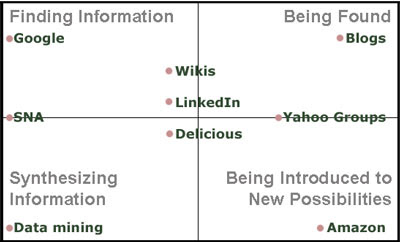Here are the six ways (quoted verbatim):
- The transformation to a bottom-up culture needs help from the top
- The best uses come from users -- but they need help to scale
- What's in the workflow is what gets used
- Appeal to the particpants' egos and needs -- not just their wallets
- The right solution comes from the right participants
- Balance the top-down and self-management of risk
In preparation for an upcoming Web 2.0 panel discussion hosted by the Boston Club, I made my own list--with inspiration & edits from Nat W.
Bruce's Technology Tips
Focus on your business goals and let those drive your technology strategy. For example, consider the following goals:
- Sales
- Marketing
- Recruiting
- Talent management
- Business development
- Innovation of core products & services
Web 2.0 Strategy Map
Technology for business is largely about storing, finding, synthesizing, and communicating information. Think about how these different tasks relate to your specific business goals. The table below summarizes how some Web 2.0 technologies relate to finding and synthesizing information:

This work is licensed under a Creative Commons Attribution-ShareAlike 3.0 License and is copyrighted (c) 2009 by Connective Associates LLC except where otherwise noted.







0 comments:
Post a Comment